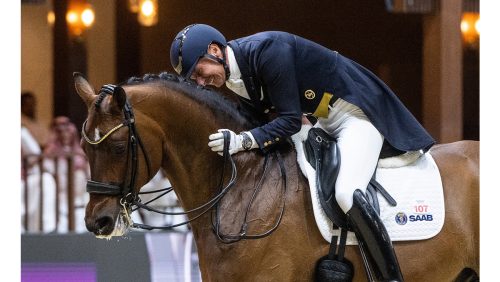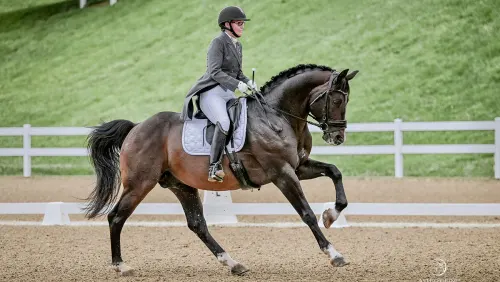 Do you believe dressage should be for every horse? Do you believe it should be judged on the presentation of the horses’ training or on their genetically provided gaits and athleticism? How important do you think the communication between horse and rider–the harmony–is in evaluating a performance? Or, perhaps to put a really blunt point on it, would you rather ride Salinero or Brentina?
Do you believe dressage should be for every horse? Do you believe it should be judged on the presentation of the horses’ training or on their genetically provided gaits and athleticism? How important do you think the communication between horse and rider–the harmony–is in evaluating a performance? Or, perhaps to put a really blunt point on it, would you rather ride Salinero or Brentina?
Dressage judges, trainers and riders should be wrestling with these questions, because together they form the big question of what–exactly–is the point of dressage? Is it to produce and reward horses with gaits so huge and powerful that only a handful of people can sit on them, especially when they have 350-horsepower temperaments? Or is it to produce and reward riding horses, horses that have been trained to collect, extend and willingly obey all our aids? And as judge Axel Steiner points out in the sidebar to our lead article “Is This Really The Age Of The Happy Athlete?” (p. 8), it’s not a purely academic question that affects only the international level.
Dressage judging has certainly evolved rather significantly in the 93 years since its Olympic introduction. And now gaits have become an increasingly large factor in judges’ evaluation as horses like Farbenfroh, Weltall, Bonfire, Gigolo and Rusty (and boatloads of young horses with “expensive” trots) have raised the bar in power, range and elasticity.
The Europeans probably don’t see the conflict that we Americans do. After all, their continent is full of people trying to breed dressage horses like the stars I just mentioned, and you can’t find a horse who isn’t an above-average mover at a show or sale. But it’s sure an issue for us, admittedly partly because our current heroine is the lovely Brentina, who, although German-bred, simply doesn’t have the range and explosive power of Weltall or Farbenfroh. But what she does have–oh, so beautifully–is a confident willingness to work in complete harmony with Debbie McDonald, a trait that creates the appearance of a pair of dancers cavorting between the little white fences.
ADVERTISEMENT
The most striking contrast to Brentina is Salinero, the winner of the Olympics and the last two FEI World Cup Finals. No one–not even Anky van Grunsven–disputes that tension (eagerness or anxiety?) is his weakness, and his demeanor teeters on the brink as van Grunsven noticeably strains to keep him mentally and physically balanced. It’s a picture of tremendous effort, of attempting to overcome a force of nature.
Still, Salinero wins almost every time, with the judges cooing about his power and van Grunsven’s tremendous riding. And in the next breath the judges will laud the cohesiveness of her not-too-demanding choreography and her custom-composed music, while calling McDonald’s inventive choreography too demanding and ignoring the foot-stomping way she expresses the well-known music she uses. And which horse looks “happier”?
You can argue that Brentina’s type is old-fashioned, that 21st century dressage is a test of the increasingly gifted horses breeders are producing. You might say it’s just evolution. That may be OK at the top, but what about the lower levels? U.S. dressage includes a broad spectrum of horses–Quarter Horses, Appaloosas, Thoroughbreds, and lower-octane warmbloods too–whose owners are attracted to the training, often after or while doing other sports. The U.S. Dressage Federation has been built on exactly this universal appeal. Does the judges’ emphasis on gaits mean that dressage will spiral inevitably toward being ever more financially elite as those exceptional movers become ever pricier? See, it’s not just a theoretical exercise.














